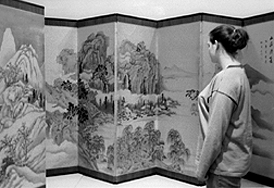








As Crossroads opens, from out of complete darkness, there is the word and only the word. . . . Adenike Sharpley, collaborator on the Crossroads production to be put on this weekend, says, "In traditional ritual, the word is necessary. It starts the power to move through space."
Thus, as Crossroads begins, two voices rise up out of the black stillness. And from the word, images and movement emerge. The images come from two TV screens and a larger screen placed at the sides and middle of the space in which the dance evolves. With the birth of movement comes dance, but also something more basic - the building blocks from which movement is constructed: flying, writhing, beating, pulsing, growing.

The production, created by Sharpley and assistant professor of art Johnny Coleman, combines elements of dance, music, visual media, props and lighting to reach the whole that is, according to Coleman, "a ritual, more than an artistic production." The project began as an installation done by Coleman in San Diego in August of 1992. This meditation on the riots in Los Angeles that summer, which is entitled "Ruminations," now forms the first part of what is now Crossroads. In 1994, Coleman began collaborating with Adenike Sharpley, who choreographed the piece as it began to grow. It now includes two additional parts and five dancers: college junior Damaris Ojeda, college sophomore Nyasha Warren, college senior Dawn Campbell, Rene Jones and artist-in-residence Michael Early.
Sharpley describes the appearance of the early stages of the work as "basically what you see here but stripped down to the bare minimum." And indeed, "what you see here" is often a barrage of images and sensory input that is not limited to what can be seen - flames on the screens; dramatic lighting effects that echo the red, orange and yellow of flames or blood; screams from the dancers; the voice of Coleman as chronicler, interviewer, speaker, and finally, in the last piece, as father.
The entire movement of three pieces, which were not designed to work together yet do so rather well, ends with a piece inspired by the birth of Coleman's son. This last piece is the simplest and gentlest of the pieces. Noises fade to just the rhythmic creaking of wood and the chirping crickets. In this last section, like the others, the theme is one of transition.
Transition from the South to the North was, for the African American, a search for heaven. What they found, Coleman says, is "that heaven is just more of the same, and this results in a kind of psychic paralysis. So all these figures are real; the trickster is real." Coleman refers to the figure who appears in the second piece as "the guardian of realms of possibilities." For the African diaspora, Sharpley says, everything happens at this realm of possibilities where the trickster sits. She says, "It is the crossroads - that charged space - that he exists in. Where four roads meet; Somethin' is always happening down on the corner."
And so the theme of the crossroads came to envelop the entire project and bring the somewhat disparate elements together, elements which Coleman calls "vehicles - vehicles that serve in a celebration." He describes the genesis of a project that "grew organically," and Sharpely says, "Although it is still evolving, it has energy and power now; it is an adult."
Transformations: Chinese themes and images in Japanese woodblock prints at the Allen Memorial Art Museum.(photo by Chandrika Rai)

Copyright © 1996, The Oberlin Review.
Volume 124, Number 18; March 15, 1996
Contact Review webmaster with suggestions or comments at ocreview@www.oberlin.edu.
Contact Review editorial staff at oreview@oberlin.edu.